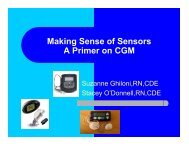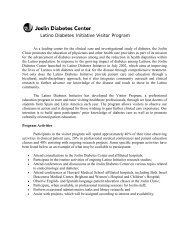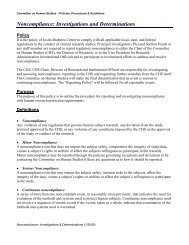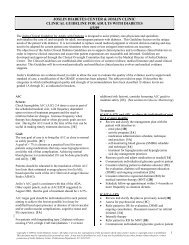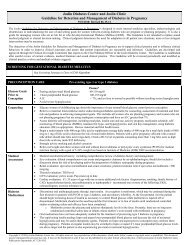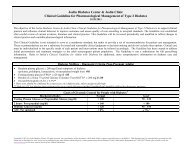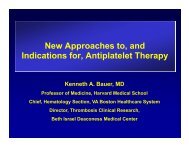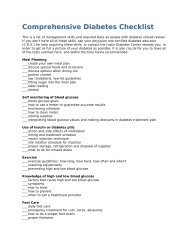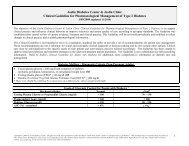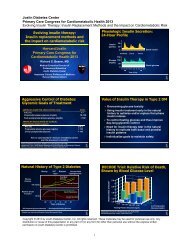Chronic Coronary Artery Disease Management - Dr Cutlip.pdf
Chronic Coronary Artery Disease Management - Dr Cutlip.pdf
Chronic Coronary Artery Disease Management - Dr Cutlip.pdf
You also want an ePaper? Increase the reach of your titles
YUMPU automatically turns print PDFs into web optimized ePapers that Google loves.
Cardiovascular <strong>Disease</strong> and Diabetes –<br />
<strong>Management</strong> of <strong>Chronic</strong> <strong>Coronary</strong> <strong>Disease</strong><br />
Donald E. <strong>Cutlip</strong>, MD<br />
Beth Israel Deaconess Medical Center<br />
Harvard Clinical Research Institute<br />
Harvard Medical School
Diabetes and <strong>Management</strong> of <strong>Chronic</strong> CAD<br />
Objectives<br />
• Prevention<br />
• Stabilize –> Prevent Acute <strong>Coronary</strong> Syndromes<br />
• Reduce Symptoms<br />
• Reduce Progression and Late Complications<br />
– Heart Failure<br />
– Cardiovascular Death
Prevalence<br />
Diabetes – A Cardiovascular <strong>Disease</strong><br />
• Framingham Heart Study – Diabetes increased risk for<br />
CHD 2 times in men and 3 times in women.<br />
• MRFIT study – 12 year risk for cardiovascular death<br />
9.7% for diabetes versus 2.6% without diabetes<br />
• Emerging Risk Factors Collaboration – Meta-analysis of<br />
102 studies with over 500,000 subjects.<br />
– Diabetes associated with doubling of risk for<br />
cardiovascular disease, cardiovascular death and MI<br />
W Kannel et al. Circulation 1979;59:8<br />
J Stamler et al. Diabetes Care 1993;16:434<br />
ERFC Lancet 2010;375:2215
Diabetes Mellitus is a CHD Equivalent<br />
DM without prior MI versus non DM<br />
with prior MI:<br />
• Future MI (20% vs 19%)<br />
• <strong>Coronary</strong> Death (15% vs 16%)<br />
Haffner S et al. NEJM 1998;339:229
Hallmarks of Diabetic <strong>Coronary</strong> <strong>Artery</strong> <strong>Disease</strong><br />
Compared to patients without diabetes -<br />
• Increased atherosclerotic burden<br />
– Diffuse disease<br />
– Multi-vessel involvement<br />
– Increased disease progression<br />
• Increased risk for acute MI and death<br />
• Poor response to medical and revascularization therapies
Diabetes and Plaque Composition<br />
• Increased unstable plaque histology based on<br />
atherectomy specimens<br />
– Increased lipid rich atheroma<br />
– Increased macrophage infiltration<br />
– Increased thrombus<br />
Plaque vulnerability<br />
Myocardial Infarction<br />
P Moreno et al. Circulation 2000; 102:2180
Diabetes and <strong>Coronary</strong> Thrombosis<br />
• Increased platelet activation and aggregation<br />
• Platelet hyperreactivity mediated in part by hyperglycemia<br />
• Elevated fibrinogen and enhanced binding to platelet GP<br />
IIb/IIIa receptor<br />
• Decreased fibrinolytic activity – increased levels and<br />
binding of plasminogen activator inhibitor (PAI-1)<br />
M Quinones et al Ann Int Med 2004; 140:700<br />
K Mather et al. JACC 2001;37:1344<br />
M Mullen et al JACC 2000;36:410
Diabetes and CAD in Women<br />
• Diabetes is an independent predictor of MI and coronary<br />
death in women.<br />
• The increased risk for coronary disease among patients<br />
with diabetes is greater for women (>3 fold vs 2 fold).<br />
• Diabetes eliminates the age gap in development of<br />
cardiovascular disease between men and women (age of<br />
high-risk for women with diabetes = 48 years).<br />
R Huxley et al BMJ 2006; 332:73<br />
GL Booth et al. Lancet 2006;368:29
Screen Asymptomatic DM Patients?<br />
• DIAD (Detection of Silent Myocardial Ischemia in<br />
Asymptomatic Diabetic Subjects 1<br />
– 22% Type 2 DM (age 50-75) + pharmacologic stress test;<br />
large defects in 5%<br />
• In retrospective series 2<br />
– 40-60% of asymptomatic Type 2 DM patients had<br />
abnormal stress tests<br />
– High-risk findings in 20%<br />
1. Wackers FJ et al. Diabetes Care 2004;27:1954<br />
2. Rajagopalen N et al. JACC 2005;45:43
Limitations of Routine Screening<br />
• 10-15% false positives and false negatives<br />
• Risk of angiography and revascularization procedures<br />
• Unproven benefit of treatment beyond risk factor control<br />
• Failure to prevent events over time – DIAD showed no<br />
difference in cardiac events among patients randomized<br />
to screening. 1 1. LH Young et al JAMA 2009;301:1547–1555
Screen Asymptomatic DM Patients?<br />
Updated ADA Recommendations<br />
• Typical or atypical symptoms<br />
• Abnormal resting ECG<br />
• Prior recommendation for screening of patients with 2 or<br />
more other CAD risk factors and prior to exercise program<br />
removed.<br />
Diabetes Care 2013;Suppl l:S32
Screen Asymptomatic DM Patients?<br />
Our Approach<br />
• Careful search for atypical symptoms (nausea, fatigue,<br />
dyspnea)<br />
• Lower threshold for patients with autonomic neuropathy<br />
• Non-imaging ETT may be of value to assess functional<br />
status and exclude symptoms (in some patients), especially<br />
prior to exercise program.
Step 1- Prevention<br />
Diabetes and Pathways to Heart <strong>Disease</strong><br />
Risk<br />
Factors<br />
Diabetes<br />
<strong>Coronary</strong><br />
Heart<br />
<strong>Disease</strong>
Glycemic Control<br />
Failure to Prevent Macrovascular Complications<br />
Therapy Trial Name Risk Reduction<br />
Oral Hypoglycemics UGDP Tolbutamide ↑ CV risk;<br />
No difference other groups<br />
Sulfonylurea/<br />
Insulin<br />
Metformin/<br />
Sulfonylurea<br />
Metformin<br />
Insulin<br />
UKPDS<br />
UKPDS<br />
UKPDS<br />
(overweight)<br />
DCCT<br />
Type 1 DM<br />
-16% (NS)<br />
+96% (DM-related mortality)<br />
-39% (p
Why Does Intensive Glycemic Control Not Reduce<br />
Diabetic Cardiovascular <strong>Disease</strong>?<br />
Complex multifactorial process that is only partially related to<br />
direct effects of hyperglycemia<br />
Tardy initiation of therapy after inflammatory and oxidative<br />
pathogenic pathways well developed<br />
“Intensive” therapy is still inadequate<br />
Most therapies increase insulin supply (sulfonylureas, insulin)<br />
versus insulin sensitizing.<br />
Libby P and Plutzky J. Circulation 2002;106:2760
% Patients<br />
Intensive Glucose Control and CV Events<br />
ACCORD and ADVANCE<br />
14<br />
12<br />
10<br />
8<br />
6<br />
4<br />
2<br />
0<br />
ACCORD<br />
Goal: HBA1C
BARI 2D – Glycemic Control Strategy<br />
Insulin-Provison<br />
N=967<br />
<strong>Dr</strong>ug Therapy Insulin (61%)<br />
Sulfonylurea (52%)<br />
Insulin-Sensitization<br />
N=977<br />
Metformin (75%)<br />
TZD (62%)<br />
(55% rosiglitazone)<br />
HbA1C (3 years) 7.5% 7.0% (p
Audience Response Question 1<br />
Which of the following is true regarding the development of<br />
cardiovascular complications of diabetes?<br />
A: Patients with diabetes have increased prevalence of<br />
traditional risk factors for heart disease<br />
B: Traditional risk factors have a greater impact on the risk<br />
for heart disease in patients with diabetes<br />
C: Diabetes has a direct effect on development and<br />
progression of heart disease unrelated to other traditional<br />
risk factors<br />
D: All of the above<br />
Correct answer = D
Diabetes and <strong>Coronary</strong> <strong>Disease</strong><br />
The Role of Hypertension<br />
• Hypertension present at diagnosis in many<br />
patients with Type 2 diabetes<br />
• Each 10 mmHg decrease in SBP associated<br />
with 12% decrease in cardiovascular risk<br />
• MI risk 33.1/1000 pt years at SBP >160<br />
and 18.4/1000 pt years at SBP
Role of Intensive Therapy<br />
What is the BP target?<br />
ADVANCE (N= 11,140, Type 2 DM at high CV risk)<br />
P=0.04<br />
• Fixed dose perindopril +<br />
indapamide versus placebo<br />
Mean FU = 4.3 years<br />
P=0.02<br />
P=0.03<br />
• Other agents including ACE-I<br />
(45% in placebo group) continued<br />
• Rx not guided by BP goal, but<br />
lower in intense group (134.5/74<br />
vs 140/76, p
Role of Intensive Therapy<br />
What is the BP target?<br />
ACCORD - Hypertension (N=4733, Type 2 DM, high CV risk)<br />
• Goal BP
LDL-C Levels and Relative Risk for CHD:<br />
How Low to Go?<br />
3.7<br />
Relative Risk<br />
for <strong>Coronary</strong><br />
Heart <strong>Disease</strong><br />
(Log Scale)<br />
2.9<br />
2.2<br />
1.7<br />
1.3<br />
1.040 70 100 130 160 190<br />
LDL-Cholesterol (mg/dL)<br />
Grundy S et al. Circulation. 2004;110:227-39.
Targeting Diabetic Dyslipidemia<br />
Is there benefit beyond statin therapy?<br />
• Niacin<br />
• AIM-High trial - extended release niacin in pts with<br />
controlled LDL but low HDL and high triglycerides<br />
stopped early due to lack of benefit.<br />
• Fibrates<br />
• FIELD trial: Fenofibrate vs Placebo in 9775 patients with<br />
Type 2 DM and mild dyslipidemia not on statins<br />
• No benefit in primary endpoint of CV death or MI;<br />
• Despite blinding there was increased statin use in<br />
placebo group.<br />
FIELD Inv. Lancet 2005;366:1849-61
Targeting Diabetic Dyslipidemia<br />
Is there benefit beyond statin therapy?<br />
ACCORD-LIPID Substudy (N = 5518, Type 2 DM)<br />
• LDL 60-180 mg/dl; HDL
Medical Therapy of CAD<br />
• Risk factor management to targets<br />
– BP
Anti-Platelet Therapy<br />
• Aspirin 75-162 mg daily if:<br />
– Known CAD (secondary prevention)<br />
– High CAD risk (10-year risk >10%)<br />
• Includes most men > 50 and women > 60 years old<br />
– Intermediate CAD risk (10-year risk 5-10%) with<br />
multiple other risk factors<br />
• Consider primary prevention at younger age<br />
– Consider clopidogrel 75 mg/day alternative if aspirin<br />
allergic<br />
Diabetes Care 2013;Suppl l:S32
Medical Rx vs Revascularization<br />
Impact of Diabetes - BARI 2D<br />
BARI 2D Inv. NEJM 2009;360:2503-15
BARI-2D<br />
Death, MI, Stroke at 5 Years<br />
Overall Results<br />
PCI Stratum<br />
42% of medical therapy group underwent<br />
revascularization during follow-up.<br />
43% of medical therapy group underwent<br />
revascularization during follow-up.<br />
BARI 2D Inv. NEJM 2009;360:2503-15
Medical Therapy versus CABG<br />
BARI-2D – CABG Stratum<br />
Death, MI, Stroke at 5 Years<br />
CABG vs. Medical Therapy<br />
• MI (10.0 vs 17.6%, p=0.003)<br />
• Death/MI (21. vs 29.2%, p=0.01)<br />
40% of medical therapy group underwent<br />
revascularization during follow-up.<br />
• Reduction in MI significant only<br />
in insulin sensitization group<br />
(6.3 vs 19.0%, p
PCI versus Medical Therapy<br />
The COURAGE Trial<br />
BARI 2D<br />
Boden WE et al. N Engl J Med 2007;356<br />
BARI 2D Inv. NEJM 2009;360:2503-15<br />
HARVARD CLINICAL RESEARCH INSTITUTE
Ischemia Reduction in COURAGE<br />
Impact on Death or MI<br />
Nuclear Substudy<br />
34% Pts with baseline<br />
mod/severe ischemia (>10%)<br />
Death or MI %<br />
40<br />
35<br />
30<br />
25<br />
20<br />
15<br />
10<br />
5<br />
0<br />
13.4<br />
Ischemia Reduction >5%<br />
RR=0.47, 95% CI 0.23-0.95<br />
p=0.037<br />
24.7<br />
No Ischemia Reduction<br />
N=82 N=232<br />
L Shaw et al. Circulation 2008;117:1283-91<br />
HARVARD CLINICAL RESEARCH INSTITUTE
COURAGE Nuclear Substudy<br />
PCI vs OMT for ischemia reduction<br />
Ischemia Reduction ≥5%<br />
40<br />
35<br />
30<br />
25<br />
20<br />
15<br />
10<br />
5<br />
0<br />
+68%<br />
33.3<br />
p=0.004<br />
19.8<br />
PCI + OMT<br />
OMT<br />
N=159 N=155<br />
L Shaw et al. Circulation 2008;117:1283-91<br />
HARVARD CLINICAL RESEARCH INSTITUTE
FAME II Trial<br />
N=888 randomized<br />
FFR ≤0.80: PCI vs Med Rx<br />
FFR >0.80: Med Rx Registry<br />
Primary Endpoint<br />
• Death, MI, urgent revascularization<br />
Critique<br />
• Terminated early by DSMB<br />
• EP driven by urgent revasc<br />
• (1.6% vs 11.1%, p
Revascularization Treatment Options<br />
Percutaneous <strong>Coronary</strong> Intervention (PCI) vs CABG<br />
• Acute <strong>Coronary</strong> Syndrome<br />
– Revascularization benefit in most patients<br />
– PCI usually preferred if feasible<br />
• Stable CAD<br />
– Single vessel (non proximal LAD) > PCI preferred<br />
– Proximal LAD<br />
• Most prefer PCI unless diffuse or complex disease<br />
• Limited comparative effectiveness data<br />
• Multi-vessel CAD<br />
HARVARD CLINICAL RESEARCH INSTITUTE
Diabetic Patients With Multivessel CAD<br />
CABG Versus PTCA or BMS<br />
Study (yrs fu)<br />
Type of<br />
N<br />
Mortality<br />
Study<br />
Risk Ratio<br />
BARI (8) RCT 353 1.87*<br />
EAST (8) RCT 90 1.56<br />
Duke databank (5) Obs 770 1.27<br />
Emory databank (6) Obs 889 1.35*<br />
NNE (2) Obs 2766 1.49*<br />
ARTS (5) RCT 210 1.61<br />
* P
FREEDOM Design (1)<br />
Eligibility: DM patients with MV-CAD eligible for stent or surgery<br />
Exclude: Patients with acute STEMI<br />
Randomized 1:1<br />
MV-Stenting<br />
With <strong>Dr</strong>ug-eluting<br />
(94% SES or PES)<br />
CABG<br />
With or Without CPB<br />
All concomitant Meds shown to be beneficial were encouraged,<br />
including: clopidogrel, ACE inhib., ARBs, b-blockers, statins
FREEDOM Trial Design (2)<br />
Design: Superiority trial of 7 yrs (minim. 2 yrs, median 3.8yrs)<br />
Sample Size: N= 1900 (953 PCI / DES vs. 947 CABG; 131 ctrs)<br />
Primary Outcome: Composite of earliest occurring of:<br />
All cause mortality, Non-fatal MI, and Non-fatal Stroke<br />
Secondary Outcomes:<br />
MACCE (Death, MI, Stroke, Repeat Revasc.) at 1 Year<br />
Survival at 1,2,3 Years<br />
MACCE Components at 30 Days Post-Procedure<br />
Cost-Effectiveness<br />
Quality of Life at 30 Days, 6 Months, 1, 2 & 3 Years<br />
Original Power: Target N=2400, Power 85% to detect at least<br />
an 18% reduction from 4-year rates ranging from 30-<br />
38 %, a = .05.
FREEDOM Results<br />
Primary Endpoint<br />
All-Cause Mortality<br />
M Farkouh et al. NEJM 2012 ; 11/4/12<br />
HARVARD CLINICAL RESEARCH INSTITUTE
BARI RCT:<br />
Relationship between IMA graft and Mortality<br />
Non-Diabetics<br />
Treated Diabetics<br />
30%<br />
30%<br />
20%<br />
20%<br />
20.6%<br />
18.2%<br />
10%<br />
10%<br />
4.6%<br />
5.4% 4.8%<br />
0%<br />
CABG<br />
+IMA<br />
CABG<br />
SVG only<br />
PTCA<br />
0%<br />
2.8%<br />
CABG<br />
+IMA<br />
CABG<br />
SVG only<br />
PTCA
Audience Response Question 2<br />
Which of the following is true regarding revascularization<br />
therapy for patients with diabetes and chronic CAD?<br />
A. All patients require revascularization.<br />
B. Stenting and coronary artery bypass surgery have similar<br />
outcomes for multivessel CAD requiring revascularization.<br />
C. Among patients with diabetes and multivessel CAD<br />
coronary bypass surgery is superior to stenting only due to<br />
lower risk for repeat revascularization procedures.<br />
D. Among patients with diabetes and CAD who are candidates<br />
for coronary stenting, initial medical therapy alone is<br />
associated with similar risk for death, MI, or stroke over 5<br />
year follow-up.<br />
Correct answer = D
Assessment and Treatment of CAD<br />
Proposed Algorithm<br />
• Aggressive management of risk factors<br />
• Stress testing if any symptoms, including atypical<br />
features – fatigue, breathlessness common<br />
• If + moderate or severe ischemia or high risk stress test<br />
(early + or drop in BP) proceed to coronary angiography<br />
• If mild-to-moderate disease by angiography or low risk<br />
stress test use anti-ischemic medical Rx as first option
Assessment and Treatment of CAD<br />
Proposed Algorithm<br />
• Revascularization Strategy<br />
– For patients who fail medical therapy or who have<br />
high risk stress test or clinical history<br />
– Stenting versus CABG<br />
• Stenting reasonable for 1-2 vessel disease not<br />
involving proximal LAD<br />
• If proximal LAD involved consider CABG instead if<br />
good surgical candidate<br />
• If 3 vessel CAD, CABG preferred unless higher<br />
than acceptable risk
Conclusions<br />
• CAD is prevalent among both men and women with<br />
diabetes – earlier age at onset and higher risk for death/MI.<br />
• Aggressive risk factor management is the cornerstone of<br />
therapy for chronic CAD.<br />
• Screening functional test may be helpful in the presence of<br />
any symptoms, including those that are atypical.<br />
• Medical management is the preferred initial strategy in most<br />
patients with diabetes and chronic CAD.<br />
• For patients with multi-vessel CAD who warrant<br />
revascularization, CABG is preferred over stenting and<br />
possibly over initial medical therapy.






